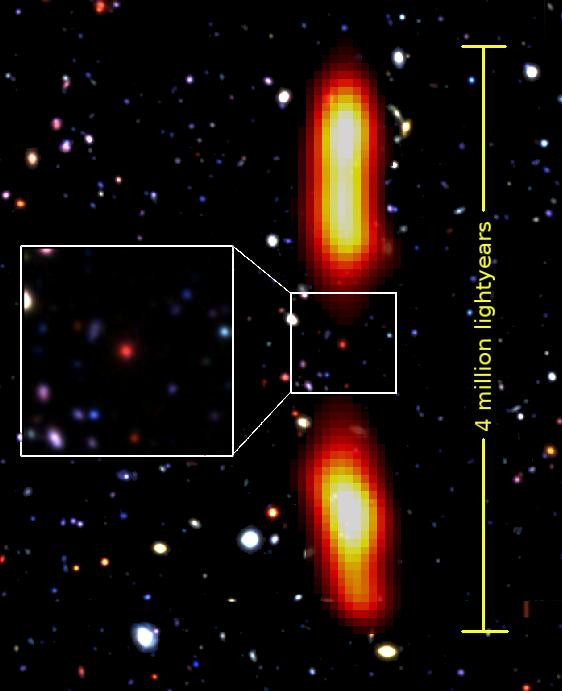Rare giant radio galaxy extending to 4 million light years discovered

Indian astronomers have discovered a rare, gigantic radio galaxy using the world's largest radio telescope operating at low frequencies. Situated at 9 billion light years away, the newly discovered galaxy "J021659-044920" is one-of-its-kind at such a distance.
Its radio waves extend to 4 million light years away, which its optical size is only a few hundred thousand light years across.
Working at the National Centre for Radio Astrophysics (NCRA, TIFR) situated close to west Indian city of Pune, the team led by a student used the Giant Metrewave Radio Telescope (GMRT) to detect the galaxy. It has been caught in its dying phase, where the giant radio lobes have started fading.
This fading is caused by loss of energy during radio wave emission and by the transferring of energy to photons from the cosmic microwave background. The latter results in faint X-ray emissions, explains a press release. Low frequency radio telescopes such as the GMRT are best suited for studying such fading radio galaxies.
A super massive black hole at the centre of the galaxy could be responsible for the massive radio lobes of the galaxy by driving large jets of hot plasma in opposite directions. However, the lobes could eventually fade when the black hole stops producing the radio jet under some situations.
Prathamesh Tamhane, a final year BSMS student of the Indian Institute of Science Education and Research (IISER-Pune) working under the supervision of Dr Yogesh Wadadekar at NCRA, led the team. It combined the GMRT observations with previous observations from the XMM-Newton Space Telescope in X-ray, the Japanese Subaru telescope in optical, UK's Infrared Telescope in near-infrared, Nasa's Spitzer Space Telescope in mid-infrared and the Jansky Very Large Array in high frequency radio bands.
The GMRT is an array of 30 fully steerable, 45 metre diameter antennas, spread out over a 30 km region in a town in Pune. The GMRT was built and is operated by NCRA and has been in operation since 2002.
© Copyright IBTimes 2025. All rights reserved.





















